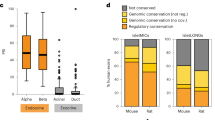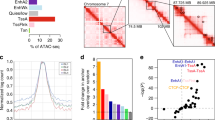Abstract
Insulin (INS) synthesis and secretion from pancreatic β-cells are tightly regulated; their deregulation causes diabetes. Here we map INS-associated loci in human pancreatic islets by 4C and 3C techniques and show that the INS gene physically interacts with the SYT8 gene, located over 300 kb away. This interaction is elevated by glucose and accompanied by increases in SYT8 expression. Inactivation of the INS promoter by promoter-targeting siRNA reduces SYT8 gene expression. SYT8-INS interaction and SYT8 transcription are attenuated by CTCF depletion. Furthermore, SYT8 knockdown decreases insulin secretion in islets. These results reveal a nonredundant role for SYT8 in insulin secretion and indicate that the INS promoter acts from a distance to stimulate SYT8 transcription. This suggests a function for the INS promoter in coordinating insulin transcription and secretion through long-range regulation of SYT8 expression in human islets.
This is a preview of subscription content, access via your institution
Access options
Subscribe to this journal
Receive 12 print issues and online access
$189.00 per year
only $15.75 per issue
Buy this article
- Purchase on Springer Link
- Instant access to full article PDF
Prices may be subject to local taxes which are calculated during checkout





Similar content being viewed by others
References
Lieberman-Aiden, E. et al. Comprehensive mapping of long-range interactions reveals folding principles of the human genome. Science 326, 289–293 (2009).
Fullwood, M.J. et al. An oestrogen-receptor-alpha-bound human chromatin interactome. Nature 462, 58–64 (2009).
Apostolou, E. & Thanos, D. Virus infection induces NF-kB-dependent interchromosomal associations mediating monoallelic IFN-β gene expression. Cell 134, 85–96 (2008).
Hu, Q. et al. Enhancing nuclear receptor-induced transcription requires nuclear motor and LSD1-dependent gene networking in interchromatin granules. Proc. Natl. Acad. Sci. USA 105, 19199–19204 (2008).
Lower, K.M. et al. Adventitious changes in long-range gene expression caused by polymorphic structural variation and promoter competition. Proc. Natl. Acad. Sci. USA 106, 21771–21776 (2009).
Cabrera, O. et al. The unique cytoarchitecture of human pancreatic islets has implications for islet cell function. Proc. Natl. Acad. Sci. USA 103, 2334–2339 (2006).
De Vos, A. et al. Human and rat beta cells differ in glucose transporter but not in glucokinase gene expression. J. Clin. Invest. 96, 2489–2495 (1995).
Eizirik, D.L. et al. Major species differences between humans and rodents in the susceptibility to pancreatic beta-cell injury. Proc. Natl. Acad. Sci. USA 91, 9253–9256 (1994).
McKnight, K.D., Wang, P. & Kim, S.K. Deconstructing pancreas development to reconstruct human islets from pluripotent stem cells. Cell Stem Cell 6, 300–308 (2010).
Onyango, P. et al. Sequence and comparative analysis of the mouse 1-megabase region orthologous to the human 11p15 imprinted domain. Genome Res. 10, 1697–1710 (2000).
Andrali, S.S., Sampley, M.L., Vanderford, N.L. & Ozcan, S. Glucose regulation of insulin gene expression in pancreatic beta-cells. Biochem. J. 415, 1–10 (2008).
Henquin, J.C. Triggering and amplifying pathways of regulation of insulin secretion by glucose. Diabetes 49, 1751–1760 (2000).
Odagiri, H., Wang, J. & German, M.S. Function of the human insulin promoter in primary cultured islet cells. J. Biol. Chem. 271, 1909–1915 (1996).
Sander, M., Griffen, S.C., Huang, J. & German, M.S. A novel glucose-responsive element in the human insulin gene functions uniquely in primary cultured islets. Proc. Natl. Acad. Sci. USA 95, 11572–11577 (1998).
Evans-Molina, C. et al. Glucose regulation of insulin gene transcription and pre-mRNA processing in human islets. Diabetes 56, 827–835 (2007).
Muller, D., Huang, G.C., Amiel, S., Jones, P.M. & Persaud, S.J. Identification of insulin signaling elements in human beta-cells: autocrine regulation of insulin gene expression. Diabetes 55, 2835–2842 (2006).
Marban, S.L., DeLoia, J.A. & Gearhart, J.D. Hyperinsulinemia in transgenic mice carrying multiple copies of the human insulin gene. Dev. Genet. 10, 356–364 (1989).
Karaca, M. et al. Transgenic expression of human INS gene in Ins1/Ins2 double knockout mice leads to insulin underproduction and diabetes in some male mice. Front. Biosci. 12, 1586–1593 (2007).
Leighton, P.A., Ingram, R.S., Eggenschwiler, J., Efstratiadis, A. & Tilghman, S.M. Disruption of imprinting caused by deletion of the H19 gene region in mice. Nature 375, 34–39 (1995).
Kurukuti, S. et al. CTCF binding at the H19 imprinting control region mediates maternally inherited higher-order chromatin conformation to restrict enhancer access to Igf2. Proc. Natl. Acad. Sci. USA 103, 10684–10689 (2006).
Vu, T.H., Nguyen, A.H. & Hoffman, A.R. Loss of IGF2 imprinting is associated with abrogation of long-range intrachromosomal interactions in human cancer cells. Hum. Mol. Genet. 19, 901–919 (2010).
Ling, J.Q. et al. CTCF mediates interchromosomal colocalization between Igf2/H19 and Wsb1/Nf1. Science 312, 269–272 (2006).
Sandhu, K.S. et al. Nonallelic transvection of multiple imprinted loci is organized by the H19 imprinting control region during germline development. Genes Dev. 23, 2598–2603 (2009).
Zhao, Z. et al. Circular chromosome conformation capture (4C) uncovers extensive networks of epigenetically regulated intra- and interchromosomal interactions. Nat. Genet. 38, 1341–1347 (2006).
Simonis, M. et al. Nuclear organization of active and inactive chromatin domains uncovered by chromosome conformation capture-on-chip (4C). Nat. Genet. 38, 1348–1354 (2006).
Gut, A. et al. Expression and localisation of synaptotagmin isoforms in endocrine beta-cells: their function in insulin exocytosis. J. Cell Sci. 114, 1709–1716 (2001).
Monterrat, C., Boal, F., Grise, F., Hemar, A. & Lang, J. Synaptotagmin 8 is expressed both as a calcium-insensitive soluble and membrane protein in neurons, neuroendocrine and endocrine cells. Biochim. Biophys. Acta 1763, 73–81 (2006).
Geppert, M. et al. Synaptotagmin I: a major Ca2+ sensor for transmitter release at a central synapse. Cell 79, 717–727 (1994).
Gauthier, B.R. & Wollheim, C.B. Synaptotagmins bind calcium to release insulin. Am. J. Physiol. Endocrinol. Metab. 295, E1279–E1286 (2008).
Gustavsson, N. et al. Impaired insulin secretion and glucose intolerance in synaptotagmin-7 null mutant mice. Proc. Natl. Acad. Sci. USA 105, 3992–3997 (2008).
Iezzi, M., Eliasson, L., Fukuda, M. & Wollheim, C.B. Adenovirus-mediated silencing of synaptotagmin 9 inhibits Ca2+-dependent insulin secretion in islets. FEBS Lett. 579, 5241–5246 (2005).
Mutskov, V., Raaka, B.M., Felsenfeld, G. & Gershengorn, M.C. The human insulin gene displays transcriptionally active epigenetic marks in islet-derived mesenchymal precursor cells in the absence of insulin expression. Stem Cells 25, 3223–3233 (2007).
Susini, S., Roche, E., Prentki, M. & Schlegel, W. Glucose and glucoincretin peptides synergize to induce c-fos, c-jun, junB, zif-268, and nur-77 gene expression in pancreatic beta (INS-1) cells. FASEB J. 12, 1173–1182 (1998).
Osborne, C.S. et al. Active genes dynamically colocalize to shared sites of ongoing transcription. Nat. Genet. 36, 1065–1071 (2004).
Schoenfelder, S. et al. Preferential associations between co-regulated genes reveal a transcriptional interactome in erythroid cells. Nat. Genet. 42, 53–61 (2010).
Hawkins, P.G., Santoso, S., Adams, C., Anest, V. & Morris, K.V. Promoter targeted small RNAs induce long-term transcriptional gene silencing in human cells. Nucleic Acids Res. 37, 2984–2995 (2009).
Ting, A.H., Schuebel, K.E., Herman, J.G. & Baylin, S.B. Short double-stranded RNA induces transcriptional gene silencing in human cancer cells in the absence of DNA methylation. Nat. Genet. 37, 906–910 (2005).
Leibiger, I.B., Leibiger, B. & Berggren, P.O. Insulin signaling in the pancreatic beta-cell. Annu. Rev. Nutr. 28, 233–251 (2008).
Phillips, J.E. & Corces, V.G. CTCF: master weaver of the genome. Cell 137, 1194–1211 (2009).
Barski, A. et al. High-resolution profiling of histone methylations in the human genome. Cell 129, 823–837 (2007).
Hutt, D.M., Baltz, J.M. & Ngsee, J.K. Synaptotagmin VI and VIII and syntaxin 2 are essential for the mouse sperm acrosome reaction. J. Biol. Chem. 280, 20197–20203 (2005).
Mutskov, V. & Felsenfeld, G. The human insulin gene is part of a large open chromatin domain specific for human islets. Proc. Natl. Acad. Sci. USA 106, 17419–17424 (2009).
Murphy, R. et al. Severe intrauterine growth retardation and atypical diabetes associated with a translocation breakpoint disrupting regulation of the insulin-like growth factor 2 gene. J. Clin. Endocrinol. Metab. 93, 4373–4380 (2008).
Bhalla, A., Chicka, M.C. & Chapman, E.R. Analysis of the synaptotagmin family during reconstituted membrane fusion. Uncovering a class of inhibitory isoforms. J. Biol. Chem. 283, 21799–21807 (2008).
Hutt, D.M., Cardullo, R.A., Baltz, J.M. & Ngsee, J.K. Synaptotagmin VIII is localized to the mouse sperm head and may function in acrosomal exocytosis. Biol. Reprod. 66, 50–56 (2002).
Fukuda, M. & Mikoshiba, K. Calcium-dependent and -independent hetero-oligomerization in the synaptotagmin family. J. Biochem. 128, 637–645 (2000).
Leibiger, I.B., Leibiger, B., Moede, T. & Berggren, P.O. Exocytosis of insulin promotes insulin gene transcription via the insulin receptor/PI-3 kinase/p70 s6 kinase and CaM kinase pathways. Mol. Cell 1, 933–938 (1998).
Babu, D.A., Chakrabarti, S.K., Garmey, J.C. & Mirmira, R.G. Pdx1 and BETA2/NeuroD1 participate in a transcriptional complex that mediates short-range DNA looping at the insulin gene. J. Biol. Chem. 283, 8164–8172 (2008).
Bartoov-Shifman, R. et al. Activation of the insulin gene promoter through a direct effect of hepatocyte nuclear factor 4 alpha. J. Biol. Chem. 277, 25914–25919 (2002).
Kitanaka, S., Sato, U. & Igarashi, T. Regulation of human insulin, IGF-I, and multidrug resistance protein 2 promoter activity by hepatocyte nuclear factor (HNF)-1beta and HNF-1alpha and the abnormality of HNF-1beta mutants. J. Endocrinol. 192, 141–147 (2007).
O'Rahilly, S. Human genetics illuminates the paths to metabolic disease. Nature 462, 307–314 (2009).
Garin, I. et al. Recessive mutations in the INS gene result in neonatal diabetes through reduced insulin biosynthesis. Proc. Natl. Acad. Sci. USA 107, 3105–3110 (2010).
Li, Y. et al. Fast skeletal muscle troponin I is a co-activator of estrogen receptor-related receptor alpha. Biochem. Biophys. Res. Commun. 369, 1034–1040 (2008).
Giguère, V. Transcriptional control of energy homeostasis by the estrogen-related receptors. Endocr. Rev. 29, 677–696 (2008).
Villena, J.A. & Kralli, A. ERRalpha: a metabolic function for the oldest orphan. Trends Endocrinol. Metab. 19, 269–276 (2008).
UK Prospective Diabetes Study (UKPDS) Group. Intensive blood-glucose control with sulphonylureas or insulin compared with conventional treatment and risk of complications in patients with type 2 diabetes (UKPDS 33). Lancet 352, 837–853 (1998).
Splinter, E., Grosveld, F. & de Laat, W. 3C technology: analyzing the spatial organization of genomic loci in vivo. Methods Enzymol. 375, 493–507 (2004).
Baskin, L., Urschel, S. & Eiberger, B. A novel ex-vivo application of RNAi for neuroscience. Biotechniques 45, 338–339 (2008).
Acknowledgements
We thank the Islet Cell Resource Centers Basic Science Islet Distribution Program for providing isolated human pancreatic islets. We thank K. Cui and D. Schones for assistance with the Solexa sequencing and pipeline analysis. This work was supported by National Institute of Diabetes and Digestive and Kidney Diseases and National Heart, Lung, and Blood Institute (US) Intramural Research Programs.
Author information
Authors and Affiliations
Contributions
Z.X. and G.F. designed the experiments; Z.X. conducted the experiments; G.W., I.C. and K.Z. conducted and analyzed Solexa DNA Sequencing experiments; Z.X. and G.F. wrote the manuscript.
Corresponding author
Ethics declarations
Competing interests
The authors declare no competing financial interests.
Supplementary information
Supplementary Text and Figures
Supplementary Figures 1–12 and Supplementary Notes (PDF 2966 kb)
Rights and permissions
About this article
Cite this article
Xu, Z., Wei, G., Chepelev, I. et al. Mapping of INS promoter interactions reveals its role in long-range regulation of SYT8 transcription. Nat Struct Mol Biol 18, 372–378 (2011). https://doi.org/10.1038/nsmb.1993
Received:
Accepted:
Published:
Issue Date:
DOI: https://doi.org/10.1038/nsmb.1993
This article is cited by
-
Chromatin conformation changes in peripheral blood can detect prostate cancer and stratify disease risk groups
Journal of Translational Medicine (2021)
-
Large parental differences in chromatin organization in pancreatic beta cell line explaining diabetes susceptibility effects
Nature Communications (2021)
-
Genetic basis and identification of candidate genes for wooden breast and white striping in commercial broiler chickens
Scientific Reports (2021)
-
Aberrant methylation underlies insulin gene expression in human insulinoma
Nature Communications (2020)
-
Enhancer reprogramming in tumor progression: a new route towards cancer cell plasticity
Cellular and Molecular Life Sciences (2018)



